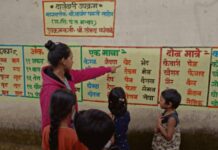It has been a little over two years since the first lockdown was announced in India aimed at curbing the spread of COVID-19 pandemic. The series of lockdowns since March 2020 has had widespread effects on the country’s economy and health. Businesses were hit, livelihoods were impacted, and schools and colleges were shut down. Although not ideal, educational institutions have had to resort to online solutions to continue the education of students. Now, as we leave the third wave behind, there is a feeling of hope and optimism. We see schools gradually reopening across the country with school leaders, teachers, parents and children eager to get back to the pre-pandemic normalcy.
While there is enthusiasm to restart all aspects of education immediately, there is a need to emphasise on re-introducing physical education among students in a phased manner.
Impact of COVID-19 and Online Education on Children’s Fitness
Physical education plays a vital role in terms of children’s gross motor development. Most children have been trapped inside the rooms with bare minimum movement—being with their mobile phone, around the television, and laptop. But when we see them on the field, their energy levels, how they communicate with their team members, and the way they coordinate what they do is so different from how they engage virtually. It indicates the much needed re-introduction of physical education and sports in schools.
—Muktikant Nayak, Sports Manager, Legacy School
A study conducted by the Sportz Village Foundation in 2018, looked at the impact of the summer holidays on the physical fitness of children. Summer holidays are usually a two to three-month gap where children do not have access to play spaces and sports infrastructure in their schools. During the study, children were assessed across a broad spectrum of physical fitness parameters, ranging from general health parameters like BMI (Body Mass Index) to strength parameters like upper body strength and core strength. There was a noticeable decline in performance across all the fitness parameters.
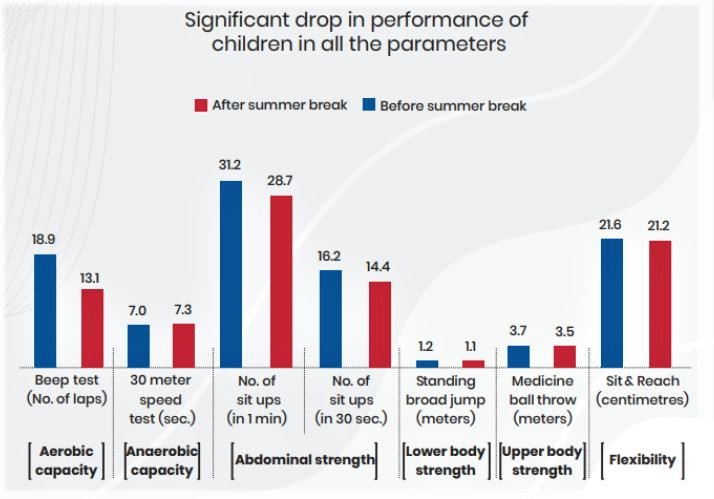
The study concludes that outside of schools, the access that children have to sports infrastructure and play spaces is limited. Even a two-month gap in meaningful and structured physical activity can lead to a drop in physical fitness and general health of children. Now think, if a two-month gap can cause such a drop in the health of children, then a two-year gap would have drastically reduced the physical fitness of children.
Dr Sridevi, a Bengaluru-based Consultant Paediatrician, says, “most children who are now coming back are on the obese side. Children have put on truncal fat [a condition where excessive abdominal fat around the stomach and abdomen builds up] and their hip-waist ratios have increased. Many who are now returning to sports are experiencing low stamina. Special care and attention need to be directed towards teenagers who are, in general, more susceptible to injuries while returning to sports such as football.”
Back to School: Assessing Students’ Physical Fitness
If we agree that physical losses exist, that too in different forms—putting on weight, low willingness to play, loss in strength and flexibility, and loss of weight—then how do physical educators and schools go about re-introducing sports and physical education?
The first step is to assess the students on certain health parameters; parameters that indicate the readiness of students to restart physical education such as aerobic capacity, BMI and strength parameters. These can be conducted during the normal P.E. classes in the schools. These assessments can help P.E. teachers and trainers understand how ready each student is. An experienced teacher or trainer would then be able to customise sessions to the needs of each student. This would not only help avoid injury, by rushing children into strenuous activity, but also ensure that all children are engaged. Sessions can also be designed to improve the parameters in which children have lower than ideal performance.
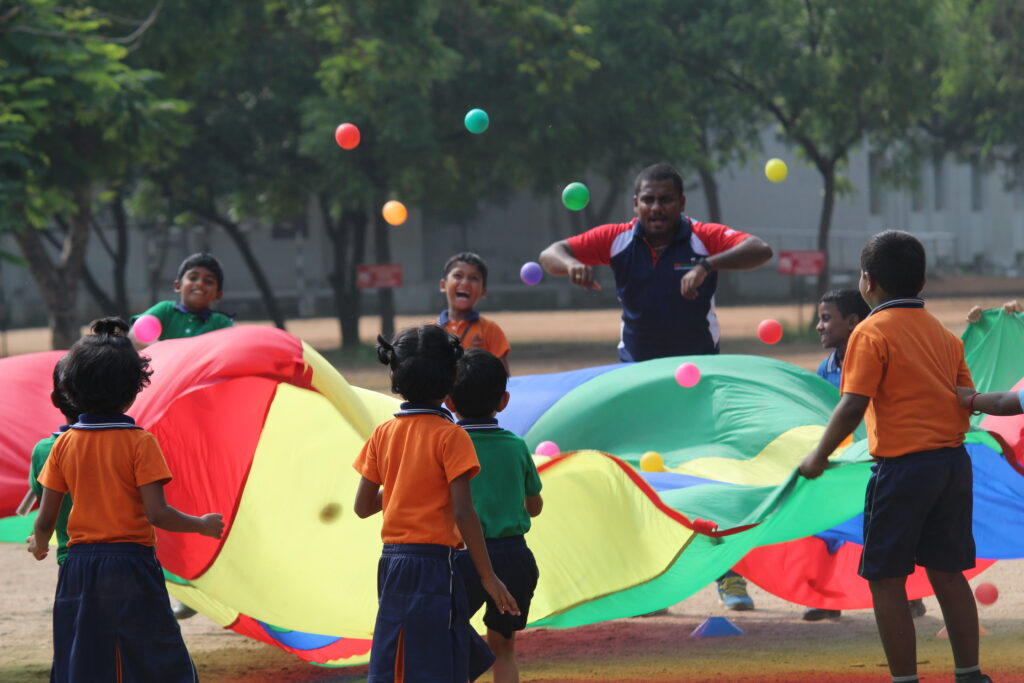
An important aspect of physical education and sports, which was lost during the pandemic period, was the interaction with peers and healthy competition. Competitive sports tournaments meet both these needs and are also a wonderful way of re-introducing the joy of sport to children.
At Legacy School, which has about 800 students, the pre-pandemic sports events would see the participation of students in several league matches throughout the year and to keep up this momentum, the school has conducted 50 matches for the students since its reopening. The preparation involved giving the students a month and a half’s time to prepare to ensure they are physically fit and attuned to the field.
Apart from organising this sporting event, the school also observed a Physical Fitness Week which was customised to specific grades and was entirely student-driven with support from the physical educators. During the week, the students discussed topics such as nutrition and health routine. This was a platform created for students to learn and reflect. What is food? What do you eat? What are the benefits of certain foods? These are all questions the students explored and incorporated one by one into their daily routine. Activities to include in the daily routine, which the students practised for a month, comprised waking up in the mornings, eating during the day, studying, playing, and sleeping at night. Competitive sports, tournaments and creative engagement are a good way to re-introduce physical education in schools. Dr Sridevi also encourages families to consider returning to normal and healthy routines, which they followed pre-pandemic. This includes their sleep routine, meal preparations, screen time and other activities during a given day.
But What about Online Classes and Community Play Spaces?
While some schools did opt for online solutions such as online P.E. classes to keep children engaged, they cannot completely replicate the benefits of in-person P.E. classes. As Muktikant says, “In these last two years of the pandemic, we had ensured that even on a virtual platform the students were completely engaged with physical activities, although they were not able to play proper sports. Their fitness was also paid attention to, with the little ones needing some extra care.”

Interaction with peers, competitive games, and time outdoors are some aspects of in-person classes that simply cannot be replicated through online sessions. These features positively affect the mental well-being of children by increasing their enjoyment. At the same time, this enjoyment pushes them to play harder, thereby improving the effectiveness of these P.E. classes.
Access to community play spaces and sports infrastructure is also dependent on the sections of the society that children hail from and prevailing local conditions. “Using public spaces, which has not been the norm of late, to play cricket or basketball or football should be encouraged. As citizens, we need to ensure that these public spaces for play are not monopolised by the clubs or monopolised by certain groups throughout the day. Children too have the right to these public spaces,” Dr Sridevi says. However, even for children who do have access, unstructured play sessions are not as effective as compared to structured sessions organised by P.E. staff.
While the broad consensus is that the pandemic is over, there is a possibility, however unlikely, of another wave rearing its ugly head. This could mean periodic school shutdowns leading to schools reverting to online classes. Over the last couple of years, we have learnt that there are limitations to online learning. Bringing in elements of competitiveness and social interaction can help address some of these limitations. Apps with features such as scoreboards have been developed by sports education organisations working with schools to track students’ performance, bringing competitiveness and motivation to the picture. Another feature of these apps is that of social activities, meant to be done by a group of children, with performances graded and monitored by competing groups. Such activities not only stimulate peer interaction but by their very design need minimal intervention or adult supervision.
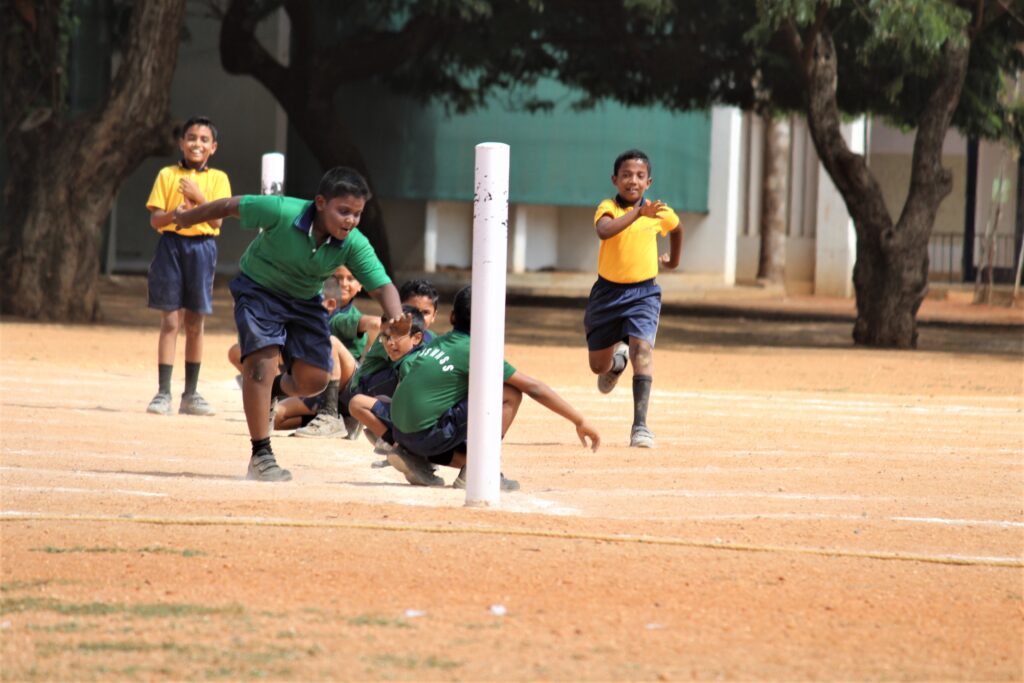
So why do sports and P.E. matter? While it is widely known and accepted that sport and physical activity is beneficial for a child’s health and well-being, the added benefits of physical activity on academic performance and mental well-being are not as well known. Studies have shown that a P.E. class prepares students to be more open to concepts and ideas that might be taught in any later academic sessions. There have also been interventions and programs where sports in government schools have helped improve attendance and classroom behaviour.
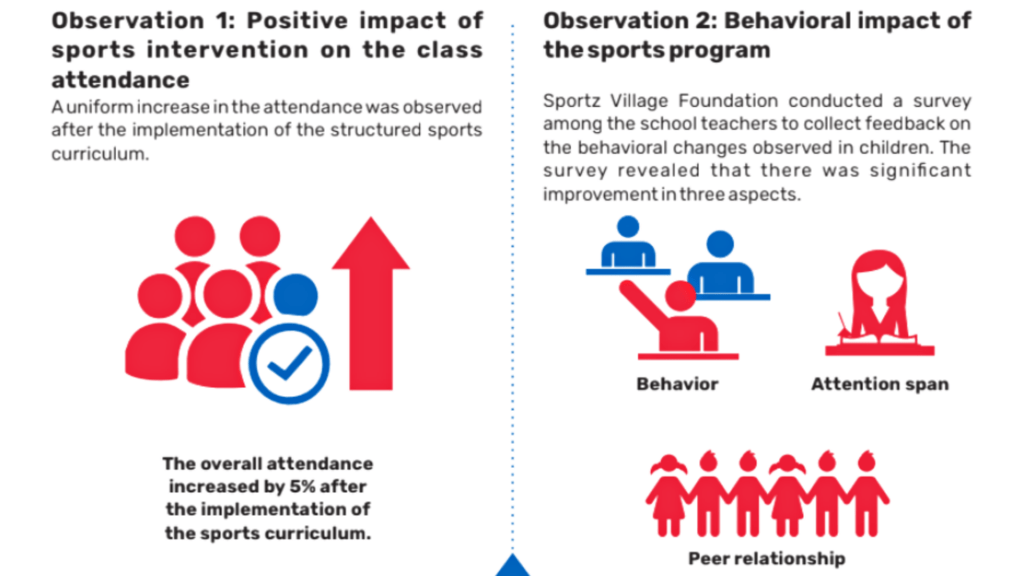
How Can Parents Support Their Child’s Physical Education?
While schools play a major part in keeping children physically active, the role of parents is also vital. The environment and routine at home are a large contributing factor to the physical, emotional and mental well-being of children. Over the last two years, Dr Sridevi has observed a shift in children’s health in upper-middle-class patients. “My patients are mostly apartment dwellers in cities who have no paucity of food and can access education and healthcare. Because most of them didn’t come to us [doctors] during the first wave of COVID-19, we were shocked to see that most of the children had put on weight later in the year, when they visited for vaccinations. Of course, this was due to the lack of physical exercise, but also thanks to the kitchen experiments that parents indulged their children in, considering eating out wasn’t really an option for many.”
The priorities of parents influence and shape the activities that children end up doing. Typically, it is seen that Indian parents prioritise academic performance over extra-curricular activities. This is understandable since academic performance plays a major role in shaping the child’s career trajectory and material success. What parents need to understand are the overall benefits, including health and mental well-being, that regular physical activity provides. Physical activity and sports are also essential in ensuring that the child develops into a well-rounded adult. “Allow them to play what they like. It is important for children to have fun and feel energised,” Dr Sridevi advises.
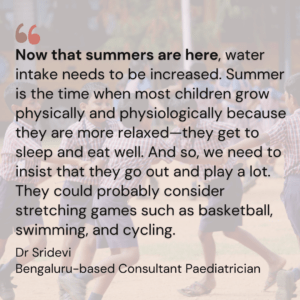 In the meantime, as summers feel unbearable and staying indoors feels comfortable, children need to be encouraged to rebuild their fitness and enthusiasm to play. This needs to be complemented by their food habits. “While re-introducing sports and physical education, special care needs to be given to the diet. Foods that add vigour need to be a part of daily meals. For children coming into clinic post-pandemic, I recommend that they can only eat junk food on anniversaries since they occur annually and are easily comprehensible by younger ones,” says Dr Sridevi.
In the meantime, as summers feel unbearable and staying indoors feels comfortable, children need to be encouraged to rebuild their fitness and enthusiasm to play. This needs to be complemented by their food habits. “While re-introducing sports and physical education, special care needs to be given to the diet. Foods that add vigour need to be a part of daily meals. For children coming into clinic post-pandemic, I recommend that they can only eat junk food on anniversaries since they occur annually and are easily comprehensible by younger ones,” says Dr Sridevi.
As schools across India gradually re-open, re-introducing sports and physical education for children should be prioritised. The absence of play in the lives of children has already impacted their health, emotional well-being and learning outcomes. While attitudes towards play by schools and parents do seem to be changing in the more affluent sections of the society, the wider society still seems to be stuck in the typical way of thinking of emphasising academic outcomes alone. What is needed is advocacy by educators, governments, and other public interest groups on the importance of physical education. Things seem to be moving in the right direction with the National Education Policy (NEP 2020) promoting sports as a vital educational tool. What is now needed is for educators and schools to implement these learnings and policy suggestions, and for parents to whole-heartedly extend their support towards the holistic development of their children.
Featured image by Udhaya Kumar of Sportz Village Foundation is of a physical trainer assessing the lower body strength of students to ensure they are physically fit to participate in sports and physical activities in school.





